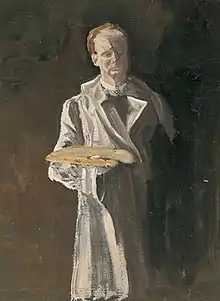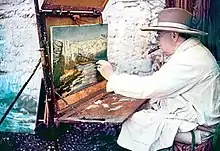Winston Churchill as painter
Winston Churchill was introduced to painting during a family holiday in June 1915 when his political career was at a low ebb. He continued this hobby into his old age, painting over 500 pictures of subjects such as his goldfish pond at Chartwell and the landscapes and buildings of Marrakesh.


1915
In May 1915, in the wake of the ill-fated Gallipoli campaign, for which Churchill was widely held to be responsible, he had been removed from his post as First Lord of the Admiralty with demotion to Chancellor of the Duchy of Lancaster. He was somewhat depressed about that turn of events and was worried about the direction his career might take in future. In June, he hired a country house in Sussex for a holiday with various members of his family, one of whom was his sister-in-law, Lady Gwendoline ("Goonie") Churchill (1885–1941), his brother's wife. Goonie was an amateur artist and Churchill watched her painting a watercolour. She invited him to take her brush and try it for himself. He was immediately captivated and painting became a lifelong hobby. He freely admitted that it revived his spirits and, as also with writing, became an antidote to his frequent bouts of depression. He began with watercolour but soon applied himself to oils.[3][4]
1920s
Churchill became Secretary of State for the Colonies in February 1921.[5] The following month, the first exhibit of his paintings was held; it took place in Paris, with Churchill exhibiting under his pseudonym of "Charles Morin".[6][7]
In September 1922, Churchill's fifth and last child, Mary, was born, and in the same month he purchased Chartwell, in Kent, which was the family home for the rest of his life. (Chartwell became a frequent source of inspiration for his paintings and Mary, who became Mary Soames, went on to write Winston Churchill: His Life as a Painter (1990) as a record of her father's art.)[8]
Soon afterwards, Churchill underwent an operation for appendicitis. While he was in hospital, the Conservatives withdrew from David Lloyd George's coalition government, precipitating the November 1922 general election, in which Churchill lost his seat in Dundee.[9] He later wrote that he was "without an office, without a seat, without a party, and without an appendix".[10] He spent much of the next six months at the Villa Rêve d'Or near Cannes, where he devoted himself to painting and writing The World Crisis, his memoirs of World War I.[11]
He was re-elected to Parliament on 29 October 1924, as Member of Parliament for Epping, and was appointed Chancellor of the Exchequer.[12] This role curtailed his hobbies somewhat but he continued to paint whenever possible, as when he took a lengthy Mediterranean holiday in January 1927, visiting Malta, Naples, Athens and Rome.[13]
References
Citations
- Cannadine 2018, p. 13.
- Rafferty 2020.
- Jenkins 2001, pp. 278–280.
- Robbins.
- Gilbert 1991, p. 431.
- Knickerbocker 1941, pp. 140, 150, 178–179.
- Soames 1990, pp. 1–224.
- Gilbert 1991, p. 450.
- Gilbert 1991, p. 456.
- Jenkins 2001, p. 376.
- Gilbert 1991, pp. 456–457.
- Gilbert 1991, pp. 462–465.
- Jenkins 2001, p. 412.
Sources
- Cannadine, David (2018), Churchill: The Statesman as Artist, United Kingdom: Bloomsbury Continuum, ISBN 978-1-4729-4521-1
- Coombs, David; Churchill, Minnie (2003). Sir Winston Churchill: His Life through His Paintings. Mary Soames (foreword). Cambridge: Pegasus. ISBN 978-07-62427-31-4. The book includes illustrations of more than 500 paintings by Churchill.
- Gilbert, Martin (1991). Churchill: A Life. London: Heinemann. ISBN 978-04-34291-83-0.
- Jenkins, Roy (2001). Churchill. London: Macmillan Press. ISBN 978-03-30488-05-1.
- Knickerbocker, H. R. (1941). Is Tomorrow Hitler's? 200 Questions on the Battle of Mankind. New York: Reynal & Hitchcock. ISBN 978-14-17992-77-5.
- Rafferty, Paul (2020), Winston Churchill: Painting on the French Riviera, Unicorn, ISBN 9781913491093
- Robbins, Ron Cynewulf, The Artist Winston Churchill - Half Passion, Half Philosophy, National Churchill Museum
- Soames, Mary (1990), Winston Churchill: His Life as a Painter, Houghton Mifflin, ISBN 9780395563199
External links
- Blood, Sweat and Oil Paint — Andrew Marr on Churchill.
- Winston Spencer Churchill – 190 Churchill paintings at Art UK
